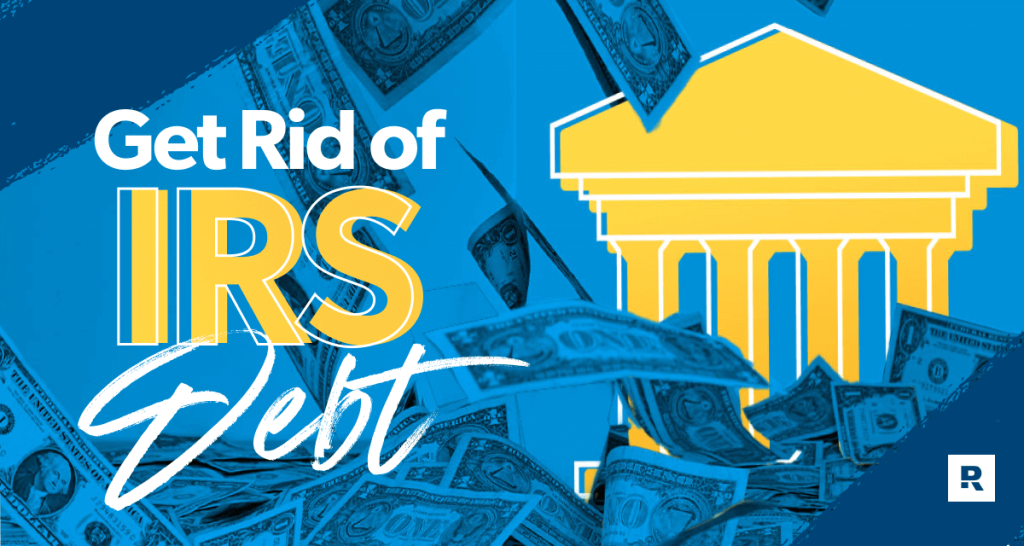Doing the dishes, making doctor’s appointments, taking out the trash. These are just some things you have to do as an adult—and taxes fall in that have-to category. If you fall behind on your taxes, it doesn’t take long for the IRS to start breathing down your neck. Yeah, it’s as uncomfortable as it sounds.
Tax debt is no fun. But what do you do when the government is hounding you to pay? First, take a deep breath. It won’t be easy, but you can get back on your feet and get the IRS off your back. We’re going to talk through the different types of tax debt relief out there and which is best for you.
What Is Tax Debt?
In case you haven’t heard, you have to file taxes every year on what you’ve earned the previous year. And if you don’t? Well, that doesn’t just go away. It becomes debt. Tax debt (often called back taxes) is any money you owe the government in unpaid taxes. Whether you didn’t pay last year or you haven’t paid for the last five years, the IRS won’t let that slide.
We’re not going to lie—tax debt is scary. The IRS has government power backing them, which means they can really screw up your life if you don’t pay them their share. Some examples include charging you outrageously high interest rates and penalty fees, placing liens on your property or taking money straight out of your paycheck or bank account. Bottom line: The IRS will come after you harder than Liam Neeson in Taken (they’ve got a special set of skills).
Types of Tax Debt Relief
If you’ve got tax debt, you need to take care of it ASAP. But if you don’t have the money to cover your back taxes right now, there are several tax relief options out there. Some are more helpful than others, so let’s dive into how each one works—and what your best option is.
Currently Not Collectible
If you’re constantly getting calls, emails and letters from the IRS about your tax debt but you don’t have any money to give them, one option is to apply for Currently Not Collectible status. If the IRS decides you aren’t able to pay your tax debt right now, they’ll temporarily stop trying to collect from you. But that doesn’t mean your tax debt goes away!
Even if your account is Currently Not Collectible, you’re still on the hook for your back taxes—and the IRS will continue to check up on you to see if your financial situation has changed. Plus, the longer you don’t pay, the more interest and fees pile up and the larger your debt grows. Applying for Currently Not Collectible status might help get collectors off your heels temporarily, but it isn’t a real solution to your tax debt problem.
IRS Payment Plan
The most common way to get rid of your tax debt is with an IRS payment plan. This lets you pay back what you owe over time. The IRS offers two options: a short-term payment plan and a long-term payment plan.
Short-Term Payment Plan
- You must owe less than $100,000
- You must pay within 180 days
- No setup fee
- Adds penalties and interest until balance is paid in full
- You can pay from your checking or savings account or by check, money order or card (preferably, debit)
Long-Term Payment Plan
- You must owe $50,000 or less and have filed your tax returns
- Repayment lasts more than 180 days
- $31–225 setup fee (unless you meet IRS low-income standards)
- Adds penalties and interest until balance is paid in full
- You can pay monthly through automatic bank account withdrawals (required if you owe more than $25,000)
The benefit of a payment plan is that you have more time to pay back your tax debt. The downside is that you’ll still be collecting interest and fees until it’s paid in full. But if you can’t pay off your back taxes in one lump sum, applying for a payment plan will at least help you start making progress.
Offer in Compromise
Another option is to apply for an offer in compromise (OIC). This is a type of tax relief that lets you settle your tax debt for less than you actually owe. Think of it like debt settlement for your back taxes. When you apply for an offer in compromise, you’re basically offering the IRS an amount you can pay in the hopes they will accept the lower amount and settle your tax debt. The IRS looks at your ability to pay, your income, your expenses and how much your stuff is worth to decide if your offer really is all they’ll be able to get from you.
Pay off debt fast and save more money with Financial Peace University.
But you should know that the odds of qualifying for an offer in compromise are pretty low. OIC applications are rarely approved, and you usually have to be in a really bad financial situation to get this kind of tax relief.
Am I Eligible for an Offer in Compromise?
In order to qualify for an offer in compromise, you need to make sure you’ve filed tax returns for every year you owe and be up to date on your tax payments for the current year. You also have to prove that paying what you owe the IRS would be a financial hardship for you. We’re not talking about having to give up your Starbucks habit or not being able to buy a new dishwasher. In this case, financial hardship means you’re so broke, you wouldn’t be able to pay rent or eat if you paid your back taxes.
If it looks like you have a decent enough income (or even the potential for a decent income) or if you’ve got money tied up in expensive assets (like cars or limited-edition action figures), the IRS probably won’t accept your offer. It’s also worth mentioning that you’re not eligible for an OIC if you’re in the middle of a bankruptcy. (And sorry, but tax debt can’t be erased through bankruptcy, so you’ll still need to take care of those back taxes at some point.)
Still not sure if you qualify for an offer in compromise? The IRS has an Offer in Compromise Pre-Qualifier tool with questions to help you determine if you’re eligible.
How Do I File for an Offer in Compromise?
After you’ve filed your returns and made sure you’re up to date on this year’s tax payments, the next step is to submit your OIC application. You also need to include the $205 application fee and your initial payment toward the offer (both are nonrefundable). (Side note: You don’t have to include any money with your application if you qualify as a low income tax payer). You’ll also need to provide a bunch of info about your income, expenses and assets. The process can be complicated, so it’s best to work with a tax advisor to make sure you’re doing it right.
When it comes to your initial payment for an offer in compromise, you’ve got two options: lump sum cash or periodic payment.
Lump Sum Cash
- Your initial payment is 20% of your offer.
- If your offer is accepted, you pay the remaining amount in five or fewer payments within five months.
Periodic Payment
- Your initial payment is your first monthly installment.
- You can keep making payments while you wait for the IRS to accept your offer.
- If your offer is accepted, you pay the remaining amount within 6–24 months.
After that, you just have to wait and see if the IRS will accept your offer. But like we’ve said before, it’s not likely that it will be approved, and the process invades your privacy almost as much as a bankruptcy. Trust us—you’re better off assuming you owe the full amount and making plans to aggressively pay it off.
What’s the Best Option to Get Rid of Tax Debt?
So, what’s your best option to get rid of your tax debt (and all the stress that comes with it)? The answer: Get on a payment plan and get serious about paying it off. We know that’s not the quick fix or magical solution you’re probably hoping for. But if there’s one debt you truly can’t hide from, it’s tax debt. Dealing with it head on and paying it off as fast as you can is the surest way to get tax debt out of your life without it coming back to haunt you later.
And don’t worry—we’re not just going to tell you to pay it all off without explaining how. Here’s your step-by-step game plan to get rid of your back taxes:
Step 1: Work With a Tax Pro
There are a lot of tax debt relief companies out there that promise to help you clean up the mess. But any time you’re dealing with the IRS, you want to be sure you’ve got a real tax professional in your corner—not someone who will take advantage of your situation.
Tax relief can get real complicated real fast, and how much you hand over to the IRS is going to depend a lot on how well you file your back taxes and fill out relief forms. When that much is on the line, it’s best to work with someone who knows their stuff and has your best interest in mind. So, before you do anything else, do yourself a huge favor and find a tax pro you can trust.
Step 2: File Your Tax Returns
Even if you owe the IRS for back taxes, you still need to actually file your taxes. You’re probably thinking, But that’s the problem. I can’t pay my taxes. Yes, but filing your taxes and paying your taxes are two different things. In fact, failing to file taxes is a literal crime.
So, make sure you file for every year you owe—even if you haven’t paid your taxes in five years. This will also let you know exactly how much you owe for each year. Otherwise, you’re just going by what the IRS billed you (which is usually an overestimate of what you actually owe—no surprise there). Remember that tax pro we mentioned? Yeah, this is where they can really help!
And don’t forget: You still need to file your taxes for this year (even if you’re worried you won’t have enough to pay by the deadline).
Step 3: Get on a Payment Plan
If you haven’t already, go ahead and apply for an IRS payment plan. If you’re not sure whether to go with a short-term or long-term payment plan, it all comes down to your income and how soon you think you can knock out your debt. But work with your tax advisor to figure out your best option. Even if you decide to pay long-term monthly installments, you can always revise your current plan to pay more each month (and get it done sooner!).
Step 4: Attack Your Debt
Don’t let off the gas just yet! Once you get approved for a payment plan, that’s when the real work begins. Remember, even with a payment plan, interest and fees are still stacking up by the day! The best way to stop your debt from growing is to attack it with everything you’ve got. Even if you have other debt, IRS debt automatically goes at the top of your list.
Go ahead and set aside as much of your next paycheck as possible to throw at your tax debt. This is the time to cut your budget way back and focus on just covering the Four Walls: food, utilities, shelter and transportation. And while you’re at it, find yourself a part-time job to help fuel the fire. This is an all-hands-on-deck situation, people! Then just keep paying big chunks as fast as you can until it’s gone. Yes, it’s intense, but so is tax debt. The more serious you get about paying it off, the sooner you can get your life back.
Get Rid of Tax Debt for Good
Phew! If you haven’t realized by now, tax debt (and debt in general) really weighs on you—not just financially, but also mentally and emotionally. It doesn’t help that the financial industry and everyone around us has made it seem like debt is the only option. The good news is, there’s another way.
If you want to learn how to make confident money decisions (without taking on the burden of debt), Financial Peace University will show you how. This course has helped millions of people learn how to budget, save, pay off debt, build wealth, and more. It’s everything you need to start taking control of your money!
You can watch Financial Peace University (and other awesome money courses) with a Financial Peace All Access membership. And bonus: When you get All Access, you can also file your federal taxes for free with Ramsey SmartTax. Say goodbye to your debt and stay on top of your taxes—all with one membership! Try Financial Peace All Access today to get started.
Read the full article here











